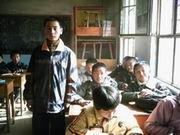1、How did your activities
and research for this International Schools CyberFair project support
content standards, required coursework and curriculum requirements?

The activity involves literature,
history, geography, computer, art and culture. We have learned
many things that are not in the text books.
We break out of the classroom, and learn from the real-life environment
and experiences and from various experts in history and culture.
Through this research project, we have learnt how to search for
information, how to conduct an interview, how to organize information.
These abilities will become our life-long assets.
In addition, Huangzhong County Museum and Ta’er Lamasery Management
Committee gave us a lot of support and help. Although due to the
busy study, we had to do the work at noon break time and weekends
and sometimes we were very tired, we have a sense of satisfaction
and fulfillment.
2、What information tools and technologies
did you use to complete your International Schools CyberFair project?

(1) Hardware facilities: computer, digital camera, recorder,
scanner, flash disk, scanner.
(2) Computer software: Dreamweaver for webpage editing, PhotoImpact
for graphic processing, Microsoft Word for textual information
editing, Outlook Express for receiving and sending mails, Internet
Explorer for browsing website, ACDSee for image browsing, CuteFTP
for transmitting information.
(3) Internet: E-mail, message board, FTP server,dial-up modem.
3、In what ways did your students
act as "ambassadors" and spokespersons for your International
Schools CyberFair project both on-line and in person. 
We consider it
our responsibility to make the public understanding the "history
of Ta’er Monastery", thus we should play the role of "community
ambassadors" and reveal this history to others.
We have tried to tell others what we know and introduced Ta’er
to school mates and villagers.
We realize our research result in the form of signboards, as
well as a homepage hosted by the school website. Apart from being
a resource for countryside education, the homepage also allows
citizens to deepen their understanding of the local history through
the Internet. The website we make is believed to make more people
know about Ta’er and Tibetan Buddhism.
4、What has been or will be the impact
of your project on your community?
Through this
research project, we have come to know more about the history
of Ta’er Monastery and Tibetan Buddhism. We are fully confident
that our work, when finished, would be the most exhaustive online
resource on “Ta’er Monastery” at the moment.
In the process of research, we have felt the public's concern
about the future development of Ta’er Monastery.Protection of
cultural assets has become the most concerned issue in the past
decade. We hope that our project would not only deepen the public's
knowledge of Ta’er Monastery, but also arouse their recognition
and passion for cultural assets.
We all have a kind of passion and
confidence unique to ourselves. Through this project, we have
established good interaction with the community. Our actions are
full of passion, and we behave with full confidence.
5、How did your project involve other
members of your community as helpers and volunteers?
We interviewed
Ta’er Lamasery Management Committee,Huangzhong County Religion
Department,Huangzhong County Museum in order to learn more about
history of Ta’er Monastery.
We interviewedTown Talent Technologies
in order towebpage construction.
6、Discoveries, Lessons and Surprises
(Optional)
We have got a
better knowledge of Ta’er Monastery’s history and the story of
Tsongkhapa. The activity has enhanced our teamwork spirit and
improved our communicating and interpersonal abilities.
|



